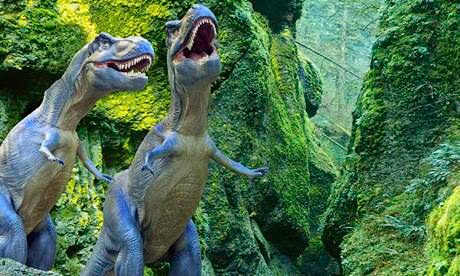
Scientists have created a detailed map of the dinosaur brain for the first time and found that the ancient beasts had the faculties for complex behaviour, and perhaps made sounds to communicate with one another.
The map provides an unprecedented view of the makeup of the dinosaur brain and a glimpse back in time at what the creatures might have been capable of during their reign on Earth millions of years ago.
“In the popular mind, dinosaurs may be underrated in the complexity of their behaviour,” said Erich Jarvis, who led the study at Duke University in North Carolina.
Soft tissues are not preserved in fossils, so researchers have had to infer the details of dinosaur brains from the faint impressions the organs leave on the insides of fossilised skulls. These “endocasts” give a sense of the size and shape of the outermost brain parts, but leave no clues about the brain’s deeper structures.
But now researchers have pieced together the innermost regions of the dinosaur brain, including six areas that are specialised for complex behaviour such as processing visual information and learning and making sounds.
Among other skills, the extinct beasts had sufficient brain complexity to communicate with sounds, Jarvis said. “But did it really happen? That we do not know.”
To recreate the dinosaur brain, the US researchers first studied the brains of alligators and birds. Alligators came from a lineage that predated many dinosaurs, while the first birds evolved afterwards. On that basis, Jarvis and his colleague Chun-Chun Chen argue that the dinosaur brain should have evolved to be somewhere in between.
The researchers drew up detailed maps of alligator and bird brains using a recently developed procedure that relies on gene activity varying across different parts of the brain. Though some genes are switched on in the brain all the time, others are activated only momentarily when something happens. This is the case for auditory regions of the brain, where genes are switched on in response to sounds.
To map the auditory regions of the brain, Jarvis quietened the animals down in a darkened room and then played bird songs to birds and alligator grunts to alligators. He then swiftly removed their brains, froze them, sliced them, and looked at the genes that had switched on in different regions.
The genetic information allowed Jarvis to make high-precision maps of bird and alligator brains, which showed the various regions and their organisation. To get the structure of the dinosaur brain he simply merged the two, and shaped the map to dinosaur brain proportions, which Chen worked out from the endocasts from Tyrannosaurus rex, an Allosaurus and the early bird Archaeopteryx.
The map of the dinosaur brain contained six regions, including one called the mesopallium involved in complex processing. “It suggests that the dinosaur brain had the capacity for complex sensory motor processing, just like we see in birds and alligators,” said Jarvis.
But while song birds learn tunes and sing them, Jarvis said, it was impossible to know whether dinosaurs were capable of a similar form of “vocal learning”.
“We don’t have any evidence that there was a dinosaur out there that did this, that shared vocal learning with songbirds. But all the brain subdivisions to support vocal learning are there, so I’d argue the capacity to evolve vocal learning did exist in dinosaurs,” he said. Jarvis described the study at the Society for Neuroscience meeting in San Diego.
“Because birds and alligators have this large cortex, it suggests that dinosaurs probably had a pretty big cortex too and were capable of pretty sophisticated behaviours,” said Michale Fee, who studies bird brains at MIT.
“It’s very unlikely that we’re ever going to find a dinosaur brain preserved anywhere, so the details are always going to have to be inferred. As we understand brain evolution better we’ll be able to make sharper speculations about what dinosaur brains might have looked like. But actually nailing it with real data is going to be hard,” he said.
Note : The above story is based on materials provided by Ian Sample, science correspondent, in San Diego for the guardian










